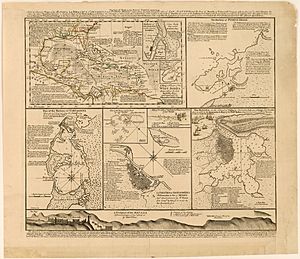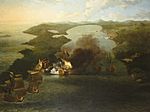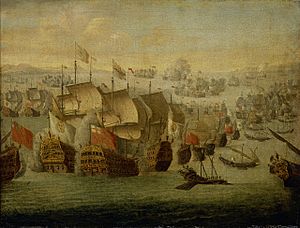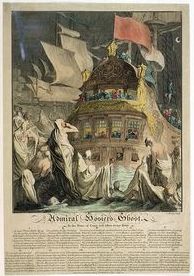Edward Vernon facts for kids
Quick facts for kids
Edward Vernon
|
|
|---|---|

Admiral Edward "Old Grog" Vernon. Portrait by Thomas Gainsborough
|
|
| Nickname(s) | "Old Grog" |
| Born | 12 November 1684 Westminster, London, England |
| Died | 30 October 1757 (aged 72) Nacton, Suffolk, England |
| Allegiance | |
| Service/ |
|
| Years of service | 1700–1746 |
| Rank | Admiral |
| Commands held |
|
| Battles/wars | |
| Other work | |
Admiral Edward Vernon (born November 12, 1684 – died October 30, 1757) was a Royal Navy officer and a politician. He had a long and important career in the British Navy. He became an admiral after serving for 46 years.
During the War of Jenkins' Ear in 1739, he successfully captured Portobelo, Panama. This victory was seen as making up for a past failure in the same area. However, his next big attack, the Battle of Cartagena de Indias, was a huge defeat. Vernon also served as a Member of Parliament three times. He often spoke out about naval issues, which made him a bit controversial.
The word "grog" for rum mixed with water comes from Vernon. He was known for wearing coats made of a fabric called "grogram." This earned him the nickname "Old Grog." Because of this, the diluted rum he gave his sailors became known as "grog." His name also inspired George Washington's famous home, Mount Vernon. Many other places in the United States are named after it too.
Contents
Edward Vernon was born in Westminster, London. He was the second son of James Vernon, who was a secretary of state for King William III. Edward went to Westminster School for a short time. Then, on May 10, 1700, he joined the Royal Navy. He started as a "Volunteer per order" on the ship HMS Shrewsbury. Most navy officers at that time had very little schooling before joining the sea around age twelve. Edward's education was quite different from this usual path.
War of the Spanish Succession
In March 1701, Edward Vernon moved to HMS Ipswich. Three months later, he joined HMS Mary. On September 16, 1702, he was promoted to lieutenant. He was assigned to HMS Lennox, which was part of the Channel Squadron. This ship later moved to the Mediterranean Sea.
In March 1704, he joined HMS Barfleur. This ship was the main ship for Admiral Cloudesley Shovell in the Mediterranean. Vernon was there when Gibraltar was captured. He also took part in the Battle of Málaga. In December, he moved with Shovell to HMS Britannia. He was present at the capture of Barcelona in 1705.
On January 22, 1706, he became a captain. He was given command of HMS Dolphin. Ten days later, he moved to HMS Rye. He stayed in the Mediterranean until 1707. He returned to England with Shovell's fleet. Luckily, he avoided the terrible accident that sank Shovell's ship, HMS Association, near the Isles of Scilly. In November, he joined HMS Jersey. In April 1708, he took charge of the West Indies station. In 1710, he successfully broke up a Spanish fleet near Cartagena. When the War of the Spanish Succession ended in 1712, he went back to Britain.
Peace and Politics
In March 1715, Vernon was assigned to HMS Assistance. He served in the Baltic until 1717. After this, he was on "half pay" for about 18 months. This meant he got half his usual salary because he wasn't actively serving. In March 1719, he was assigned to HMS Mary and returned to the Baltic. In 1720, Vernon was a commodore on the Jamaica Station.
In 1721, he was again on half pay for five years. During this time, he became a Member of Parliament (MP) for Penryn. This was the same area his father had represented. He became a key speaker in Parliament about naval matters.
In 1726, he returned to active service on HMS Grafton. This ship served in the Baltic until 1727. Then it moved to Gibraltar after Spain declared war on Britain. In May 1728, peace was made with Spain. Vernon returned to Britain and continued his work in Parliament.
War of Jenkins' Ear

Many conflicts between Spain and Britain led to the War of Jenkins' Ear in 1739. Vice Admiral Vernon led a fleet with Major General Thomas Wentworth. Vernon captured Portbelo, Panama, a Spanish area. For this, he was given the Freedom of the City of London.
However, Vernon's next big attack was a large assault on Cartagena de Indias in 1741. This attack ended very badly. The British fleet had 186 ships and about 12,000 soldiers. But they were defeated by only 3,500 Spanish defenders. The Spanish admiral, Blas de Lezo, was a skilled leader.
British troops got sick, and the Spanish used clever delays. A final attack on the city's main fort failed. The British decided to give up and go back to Jamaica. Vernon and Wentworth also had many bitter arguments. After another year and a half of fighting in the Caribbean without much success, Vernon was called back to England. He found out he had been elected as an MP for Ipswich.
During the War of Jenkins' Ear, Vernon was promoted to vice admiral on July 9, 1739. He had spoken strongly for both the war and the Navy. So, he was given command of six ships for the Jamaica Station. The Gentleman's Magazine reported England's war preparations in July 1739. It noted Vernon's promotion and that he had sailed for the West Indies on July 20. The official war declaration against Spain was made in London on October 23, 1739.
Capturing Portobelo

On November 21, 1739, Vernon captured the Spanish town of Portobelo, Panama. He used only six ships against the 90 Spanish defenders. This was a great victory!
Vernon was given the Freedom of the City of London. Special medals were made to celebrate. Areas in London, Dublin, and Edinburgh are named Portobello after this victory. The famous song "Rule, Britannia!" was written during the celebrations in 1740. A tower was built near Wolverhampton to remember his win.
Vernon's victory was seen as revenge for Admiral Hosier's failed attempt at Portobelo years earlier. Hosier had more ships but was not allowed to attack. Many of his sailors died from disease. A famous song, "Admiral Hosier's Ghost," was written after Vernon's triumph. It reminded people of the past failure and praised Vernon's success. The song said that Hosier's ghost congratulated Vernon for doing with six ships what Hosier could not do with twenty.
The Disaster at Cartagena de Indias

In 1741, Vernon led a huge fleet of 195 ships and about 30,000 men. Their goal was to capture the Spanish port of Cartagena de Indias. This was a very important port in the Spanish colonies. The city was defended by the Spanish admiral Blas de Lezo.
The British fleet had about 2,000 cannons. It included many large warships and transport ships. The city of Cartagena had about 3,000 defenders. These included soldiers, local fighters, and sailors from six warships.
The British captured some of the city's defenses. But their attack on the main fort, San Felipe de Barajas, failed on April 20. Many British troops were sick. They also suffered heavy losses in the fighting. The rainy season was starting, which made things worse. So, the British decided to destroy what they could and leave the siege.
The British lost about 4,500 men. Six ships were lost, and many more were badly damaged. This defeat forced the British government to focus its navy closer to home. It stopped new attacks on Spanish colonies in America. The defeat at Cartagena changed British war plans. It allowed Spain to keep control of the region for many more years. The British had been so sure of victory that they had already made coins and medals to celebrate. These medals said things like "British heroes took Cartagena April 1, 1741" and "Spanish pride humiliated by Vernon."
Vernon's expedition continued in the Caribbean. They tried to attack Santiago de Cuba. But the Spanish governor and a French engineer had a strong defense plan. Vernon captured Guantánamo Bay for a short time. He planned to march on Santiago de Cuba. But he gave up in December after sickness spread again. Vernon became very angry with Wentworth's leadership. Their arguments led to both of them being called back to Britain in late 1742.
While Vernon was away, he had been elected as an MP for Ipswich. He had bought the Orwell Park estate in Nacton, Suffolk. Vernon returned to Parliament. He kept criticizing the government about naval issues.
In 1745, Vernon was promoted to admiral. He was given command of the North Sea Fleet. This was to deal with a threat from French forces supporting "Bonnie Prince Charlie." This was his last active command. The Admiralty (the navy's leaders) would not make him the top commander. So, he asked to be relieved on December 1, 1745.
Vernon's navy career ended in a controversial way. He wrote two pamphlets (small books) about his disagreements with the Admiralty. As a result, King George II decided to remove his name from the navy's list of officers. He was dismissed on April 11, 1746. After this, his political career became less important. But he kept his Ipswich seat in the 1754 election.
Throughout his career, Vernon tried to make naval procedures better. He encouraged his captains to improve ship movements and gun practice. He created new instructions to make fleets more flexible in battle. These ideas helped improve how the Royal Navy fought. Vernon continued to serve in Parliament. He remained active in naval affairs until his death in Nacton on October 30, 1757.
His most lasting legacy is his 1740 order. He ordered that sailors' rum should be mixed with water. This new drink was supposedly called "grog" after Vernon's nickname, "Old Grog." He got this nickname because he often wore a coat made of "grogram" cloth. Some people have said that Vernon also added citrus juice to prevent spoilage and scurvy. This is not true. His order only said that sailors who were careful with their food could buy sugar and limes to make the diluted rum taste better.
Scurvy was a serious disease on long ocean voyages. Doctors at the time thought it was caused by bad digestion. They tried many ineffective remedies. It wasn't until 1795 that the Royal Navy officially gave lemon juice to sailors every day. This finally helped prevent scurvy. Sailors and surgeons had known from experience that citrus juice cured scurvy. In 1795, the Admiralty started giving lemon juice and sugar as a regular part of the navy diet. When lemons became hard to get, West Indian limes were used instead. This is how British sailors got the nickname "limeys."
Mount Vernon
George Washington's older half-brother, Lawrence Washington, served under Vernon. He was a captain of Royal Marines on Vernon's main ship, HMS Princess Caroline, in 1741. Lawrence named his Virginia estate Mount Vernon to honor his former commander. George Washington kept this name for the estate.
|
See also
 In Spanish: Edward Vernon para niños
In Spanish: Edward Vernon para niños




